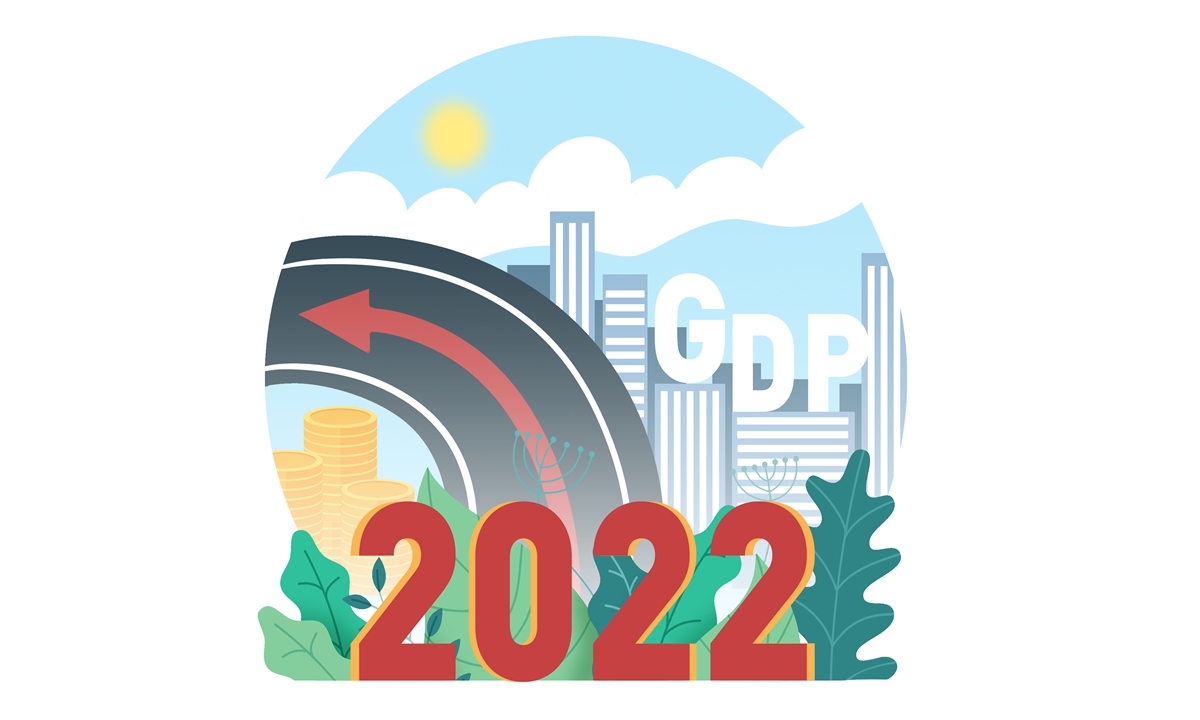
Illustration: Chen Xia/Global Times
Financial and fiscal policy easing is expected to be the new approach taken by China's policymakers to jumpstart a significant slowdown of the world's second largest economy, which grew impressively in 2021 to reach $18 trillion. Riding on a favorable tide, which include low inflation at home and unprecedented levels of support from 1.4 billion people, the government should aim at another year of relatively high growth.
A clear reminder is that the policymakers should continue to underline rural development by encouraging farmers to raise livestock and grow vegetables, fruit and other produce in order to keep inflation at bay.
Only when consumer price rises are curbed within 2-2.5 percent elevation, China will have the leeway needed to pursue policy easing in 2022. Right now, inflation is at 30-year highs in Europe, with Britain and Germany both recording more than 5 percent inflation in December. The US saw its inflation skyrocket to 40-year high of 7 percent in the same month.
In addition to abundant market supply of pork, eggs and other foods, China launched a property sector rectification drive in the second half of last year to deleverage debt levels of major property developers, which dampened prices of housing as well as home rents. As a result, despite global prices of energy and other raw materials rose, China was able to control its yearly inflation at only 0.9 percent in 2021, setting the foundation for counter-cyclical macro policy adjustment now.
To spur economic growth, China's central bank moved to cut two benchmark lending interest rates on Thursday, which will help the country's cooling economy stabilize and avoid a hard landing. And, during the annual legislative session of the National People's Congress (NPC) in early March, a new package of fiscal spending plans will likely be approved, setting the agenda for another round of robust government-led capital investment in the country.
The People's Bank of China, the central bank, reduced the one-year loan prime rate (LPR) on which most new and outstanding loans are based, to 3.7 percent from 3.8 percent, and the five-year loan prime rate, which is a reference rate for mortgages, to 4.6 percent from 4.65 percent.
If no prompt measures are taken by China's central authorities, the risk of a hard landing may increase. The world's second largest economy slowed down to 4.0 percent growth in the last quarter of 2021, although growth for the whole year reached 8.1 percent, thanks to robust development in the first six months.
In 2022, accelerated monetary easing and fiscal stimulus programs are likely to be meted out - such as further cuts of the LPR and the commercial banks' reserve requirement ratio, as China now faces a flurry of headwinds, including global supply bottlenecks, ongoing tariffs and technology war with the US, and property sector doldrums at home.
Also, the policymakers are closely watching the course of the pandemic for its impact on domestic consumption, which will be an important predictor of the economic growth this year. Sporadic coronavirus flare-ups that had led to strict restrictions in several large cities like Tianjin and Xi'an, and heightened caution nationwide has dragged down demand for services.
This year is of great significance for the Chinese people. It is imperative for China's policymakers to maintain a stable GDP growth and employment rates in 2022, a year marking the country's efforts to deepen structural reforms and make new progress in technology competition with the US. And, the all-important 20th National Congress of the Communist Party of China is set to be held in Beijing in the autumn.
China's economy grew in size to 114.4 trillion yuan ($18 trillion) last year, which accounted for roughly 80 percent of the US' GDP, which is predicted to have grown 5.7 percent to reach $22.5 trillion in 2021. The Chinese government's strong investment in infrastructure, such as on high-speed rail expansion and 5G broadband, combined with the country's outsize manufacturing industry and its unparalleled export capability, are two major drivers of China's hectic growth.
Although Chinese government officials have repeatedly stressed that they are not interested in whether and when China's GDP will surpass the US in nominal dollar terms, many Chinese economists and ordinary people are pinning hope on the policymakers to work more diligently and creatively to speed up the pace of growth.
Barring big natural disasters, China's GDP is likely to rise 5.5-6.0 percent in 2022. To date, as many as nine Chinese provincial-level regions have set their GDP growth targets this year at above 6 percent, while powerhouses economies like Guangdong, Beijing and Shanghai set their growths at above 5 percent.
The Chinese Academy of Social Sciences (CASS), a major government think tank, forecasts that the country could achieve at least 5.5 percent GDP growth in 2022, which has struck a chord with the general public.
Last week, Liu Guoqiang, vice governor of the People's Bank of China, stated that the central bank should "hurry up, make operations forward-looking, move ahead of the market curve, and respond to the general concerns of the market in a timely manner". Then the bank came out with several items of policy front-loading, with the reduction of both the one-year and five-year loan prime rates, which will push down business borrowing costs and may work to catapult the cash-hungry property sector out of its woes, soon.
Policymakers set a few "red lines" to curb the debt levels of property developers that led the property sector to a considerable correction with sharply lower home sales and new land development. Several major developers, such as Evergrande Group, have encountered difficulties in paying back loans and bonds. Beginning this year, authorities have pushed lenders to increase the volume of mortgage loans to revitalize the sector.
The author is an editor with the Global Times. bizopinion@globaltimes.com.cn




